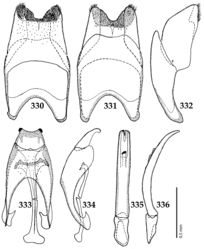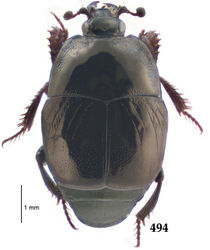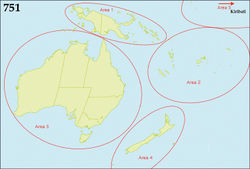Saprinus pacificus
| Notice: | This page is derived from the original publication listed below, whose author(s) should always be credited. Further contributors may edit and improve the content of this page and, consequently, need to be credited as well (see page history). Any assessment of factual correctness requires a careful review of the original article as well as of subsequent contributions.
If you are uncertain whether your planned contribution is correct or not, we suggest that you use the associated discussion page instead of editing the page directly. This page should be cited as follows (rationale):
Citation formats to copy and paste
BibTeX: @article{Lackner2017ZooKeys, RIS/ Endnote: TY - JOUR Wikipedia/ Citizendium: <ref name="Lackner2017ZooKeys">{{Citation See also the citation download page at the journal. |
Ordo: Coleoptera
Familia: Histeridae
Genus: Saprinus
Name
Saprinus pacificus Lackner & Leschen, 2017 sp. n. – Wikispecies link – ZooBank link – Pensoft Profile
Type locality
Kiribati: Bikinibeu.
Type material examined
Holotype, ♂, side-mounted on a triangular card, with propygidium and pygidium detached, glued to the same triangular card as specimen, terminalia also glued to the same triangular card as specimen, with the following labels: “KIRIBATI / Bikenibeu / N. 1977 / P.J. Simmonds” (written); followed by: “Assoc. with / poultry / dung” (written); followed by: “SAPRINUS / sp. 2 / Det. T. Lackner 2009” (printed-written); followed by: “Saprinus / nitiduloides / Det. S. Mazur” (printed-written); followed by: “09-078” (yellow label, pencil-written); followed by: “Saprinus (Saprinus) / pacificus sp. n. / HOLOTYPE / Lackner&Leschen 2010” (red label, printed) (NZAC). Paratypes, 1 ♂ & 4 specs., with the following labels: “KIRIBATI / Bikenibeu / N. 1977 / P.J. Simmonds” (written); followed by: “Assoc. with / poultry / dung” (written); followed by: “Saprinus (Saprinus) / pacificus sp. n./ PARATYPE / Lackner&Leschen 2010” (red label, printed) (NZAC; 1 PT in coll. TLAN).
Distribution
Kiribati atoll (Fig. 751).
Biology
Collected in association with poultry dung.
Remarks
Because the following newly described species, S. pacificus sp. n., is in its general appearance rather similar to the preceding species S. nitiduloides we provide it with only diagnostic description. The figures, as well as male genitalia drawings are kept, for the sake of easier identification of the Australopacific taxa.
Diagnostic description
This species is in its general outlook rather similar to S. nitiduloides (compare Figs 477 and 494); body length: PEL: 3.25–4.00 mm; EL: 2.00–2.35 mm; APW: 1.15–1.40 mm; PPW: 2.40–3.00 mm; EW: 2.75–3.25 mm. Antennae (Fig. 495–496) similar to other congeners, e.g. S. cyaneus (Fig. 409) or S. nitiduloides (Fig. 478).
Mouthparts similar to congeners; mentum (Fig. 497) with deep median notch on anterior margin, surface around it with two long setae and several much shorter setae, lateral margins with two rows of short ramose setae, disc of mentum finely imbricate, with sparse short setae. Clypeus and frons (Fig. 495) similar to those of S. nitiduloides (compare Fig. 478 with Fig. 495); frontal stria prolonged onto clypeus and also almost complete along anterior frontal margin (occasionally intermittent). Pronotal sides moderately narrowing anteriorly, pronotal depressions deeper and apical angles more prominent than with S. nitiduloides (compare Figs 477 and 494). Elytral structure and configuration of elytral striae similar to those of S. nitiduloides, but punctation even sparser, punctures separated by several times their diameter (compare Figs 477 and 494). Propygidium and pygidium very similar between the two species (compare Figs 479 and 498). Prosternum structurally similar to that of S. nitiduloides, but the course of carinal prosternal striae differ between the two species: while sub-parallel and slightly narrowing before apex in S. nitiduloides (Fig. 480) they are slightly widening anteriorly with S. pacificus (Fig. 499). Mesoventrites similar between the two species, but that of S. pacificus slightly wider than that of S. nitiduloides and its punctation finer; furthermore the lateral mesoventral stria almost complete with S. pacificus while shortened apically with S. nitiduloides (compare Figs 481 and 500). Metaventrites and metepisternal similar between the two species (compare Figs 482 and 501). Protibia (Fig. 502) similar to that of S. nitiduloides (Figs 483–484); mesotibia (Fig. 503) and metatibia similar to other congeners (e.g. S. artensis). Male genitalia. Eighth sternite (Figs 504–505) with pseudo-pores, weakly separated on apical third, otherwise fused, apex with velum adorned with dense rows of brush-like setae; laterally apex of eighth sternite with a single row of microscopic sparse setae; eighth tergite and eighth sternite fused laterally (Fig. 506). Ninth tergite (Figs 507–508) typical for the subfamily; anterior margin of tenth tergite straight, apical angles strongly sclerotized, bent; spiculum gastrale (Fig. 507) abruptly dilated on apical third; apical end strongly sclerotized, with protruding horn-like structures and tiny median notch; basal end only slightly dilated, outwardly arcuate. Aedeagus (Figs 509–510) parallel-sided, with parameres fused along their basal half (roughly); basal piece of aedeagus short, ratio of its length: length of parameres 1 : 4; aedeagus slightly curved from lateral view (Fig. 510). Male terminalia of S. pacificus sp. n. are similar to those of S. artensis, S. cyaneus cyaneus, and S. nitiduloides especially regarding strongly sclerotized apices of tenth tergite. Although the structure of spiculum gastrale or ninth tergite is also similar between the four species, they differ in the structure of eighth tergite. Their aedeagi, on the other hand, are strikingly similar indicating their recent common ancestry (compare Figs 330–336; 415–412; 487–493; 504–510).
Original Description
- Lackner, T; Leschen, R; 2017: A monograph of the Australopacific Saprininae (Coleoptera, Histeridae) ZooKeys, (689): 1-263. doi
Images
|









